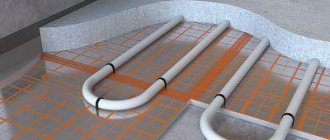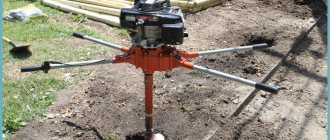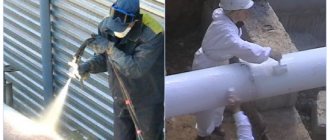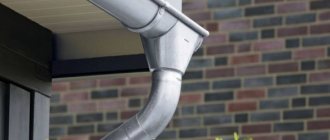Do-it-yourself drainage of the area around the house
If the site is located in a lowland or groundwater flows close to its surface, it is necessary to drain the area. It is optimal when the groundwater level is at a depth of more than 2.5 m from the surface.
If the distance is less than 1.5 m, then the bearing capacity of the soil decreases - it becomes waterlogged and saturated with water. This affects the settlement of the foundation and makes the construction of a basement or ground floor problematic.
To drain the area around the perimeter of the planned house, or better yet along the edges of the entire yard, they dig channels with a slight slope and organize drainage. The optimal width of such channels is 50-70 cm.
The depth is calculated in each case individually, since it depends on how much the groundwater level needs to be lowered. Drainage is laid as follows.
At a distance of 2-3 m from the house, dig a ditch with a depth equal to the base of the foundation. A 15-20 cm layer of clay is placed on its bottom, giving it the shape of a tray. Medium-sized stones are carefully laid on top, forming sides. Large stones are placed on top, forming a vault. Gravel or crushed stone 25-30 cm high is placed on it. Everything is covered with soil removed during excavation. Water will seep through the soil into the tray and flow in the desired direction.
How to drain melt and storm water from the foundation
To protect the foundation of the house from rain and melt water, you can use a blind area. Water can be drained by installing surface drainage trays along the blind area. It is worth remembering that in the spring the trays will become clogged very quickly, because melt water will run freely across the frozen ground without being absorbed into it.
Foundation blind area
In addition, at night the temperature will drop, the water will freeze, its drainage will be impossible, and the trays will become useless. It is more advisable to use a device made from trays in the summer: storm water will freely flow from the lawns directly into the drainage device. In addition, you can drain water with your own hands almost free of charge and more efficiently. This method is called watershed creation and landscape modeling.
To create a watershed, all you need is a shovel, a rake and a wheelbarrow to transport the earth. First of all, the parameters of the watershed are calculated: shape, length and width. A direct watershed line is drawn in large areas: near a private house, cottage, parking lot.
Small objects are limited by an arc-shaped watershed, at a distance of about four meters from the beginning of the foundation. In this case, drainage is carried out into a ditch or a special drainage well.
After marking the watersheds, you can begin to create them.
Drainage system
The purpose of a roof drainage system is to collect rain and melt water from the roof of a building and redirect it to drainage points. If there are no gutters or they are not constructed correctly, then the water flowing from the roof moistens the walls (this is especially dangerous for wooden buildings and unfinished exteriors of sand-lime brick houses), destroys the blind area and undermines the foundation.
If the roof has a large area and the flow of water from it is strong enough, it breaks up the garden paths, and the building ends up splashed with soaked mud for almost half a meter
The main rule when installing gutters is to divert water as far as possible from the foundation of the house. After all, if you install water collectors immediately under the drainpipes, the moisture will go into the ground under the foundation, and only the walls and garden paths will be protected! In addition, the soil adjacent to the foundation is usually looser than usual, so water quickly absorbs into it and seeps to the concrete base. In winter, it freezes, expands and begins to “tear” concrete structures.
To prevent this from happening, a blind area up to one meter wide is made around the perimeter of the house and drainage trays or point storm inlets are installed, which direct water flows into storm drains, drainage wells, etc. depending on the general drainage system on the site.
What types of drainage systems are divided into?
Superficial. Such systems are point and linear.
Point ones are located in places where water often accumulates:
- under the drainpipe;
- near the entrance to the house.
The construction of linear systems involves laying shallow trenches along the perimeter of the site.
Deep. Systems for collecting and draining groundwater, which are branched networks of perforated pipes.
Preparatory work
- The technology for installing a drainage system at the first stage involves studying the site. This is necessary in order to determine the angles of inclination.
- Those who approach the matter in detail will definitely take up the preparation of a detailed project. The slope must be at least 5 millimeters per 1 meter. Inspection wells are provided to simplify the operation and cleaning of pipes.
- The installation of drainage systems is associated with some difficulties associated with the need for excavation work. Thus, such activities should be carried out when planting plants and trees is not planned.
Performance of work requires the presence of:
- wheelbarrows, level, pegs, rope, rammer, trowel
- plastic wells, coarse river sand;
- shovels, tape measures, grinders or hacksaws
- drainage pipes (flexible corrugated or rigid perforated);
- trays, gratings, couplings, fittings, cement;
- gravel (crushed stone with a fraction of 20-40 millimeters is suitable);
- geotextiles.
Installing a drainage system on a site cannot be called a low-cost and simple procedure. How long the drainage will function properly depends on the quality of the materials. Therefore, it is not worth saving on them.
Reliable ways to drain water from the foundation of a house
Korovin Sergey Dmitrievich
Master of Architecture, graduated from Samara State University of Architecture and Civil Engineering. 11 years of experience in design and construction.
The foundation is the basis, the support of the building; the life of the house depends on its quality, strength and integrity. The integrity of the foundation is compromised, first of all, under the influence of water that comes into contact with it during rains, runoff of melted snow, rising groundwater levels (or constant presence of groundwater at a high level), etc. As a result, the foundation walls become wet, damp, and overgrown with mold. , and moisture gradually collects around and approaches the upper floors.
All of the above problems demonstrate the importance of timely drainage from the foundation of a building. Moreover, foundation drainage must be carried out during the process of creating a residential structure in order to carefully consider the design of the drainage system, calculate the angle of inclination, select suitable materials for drainage and calculate the depth at which structural elements should be located
What is a drainage system and why is it needed?
A drainage system is a complex of elements that includes special pipes or trays that are designed to drain excess moisture from the site. The water collected in a special storage tank is removed from the site into the nearest ravine or reservoir through a special drainage system. The main purpose of the drainage system on the site is to protect the foundation from the harmful effects of groundwater and ensure optimal soil moisture levels, which helps increase the yield of garden crops.
Increased soil moisture associated with shallow groundwater, heavy rainfall or intense snow melting can cause serious problems:
- The presence of excess moisture in the soil contributes to its unevenness under and around the foundation. This will not cause any problems if the house is built on a pile or pile-screw foundation, however, if the house is on a shallow foundation, there is a high probability of frost heaving during the cold season.
The frozen soil under the foundation acts on its base and pushes it upward, while the supporting structures do not experience such movement. This can lead to both the destruction of the foundation itself and the walls of the building. A similar situation may arise with paths paved with paving slabs or other material.
- high humidity promotes the spread of mold and other fungi, worsens the overall microclimate in the room and provokes colds and respiratory diseases. There have been cases where the spread of mold resulted in a building having to be demolished;
- excess moisture leads to rotting of the root system of domestic plants, which leads to a decrease in yield and their death;
- If an outbuilding or garage is located on damp ground, premature corrosion of tools, cars and other metal objects and structural elements is inevitable.
Protection of the foundation from melt and storm water
Protection against melt water
Seasonal formation of surface water is also a big problem. It can be solved with the help of comprehensive protection, which includes a drainage system, blind area and drainage system.
Drainage system
The design is designed to collect rain or melt water from the roof of a house. Water flows through special gutters into funnels and is carried away from the foundation of the building through pipes.
Ring drainage helps drain stormwater away from the foundation. It works like this:
Pipes are laid in an open trench that lead to a general sewer system. The pipes are laid on a compacted bed of sand and crushed stone.
It is very important that the diameter of the drainage and downspout pipes be the same. Wells are installed that receive water from drains. All water is collected in a common well, from which it is removed by pumping, direct drainage into an open reservoir, or absorbed into the soil through a drainage field.
Blind area
Water that accumulates on the surface is drained from the foundation using a blind area. Its arrangement looks like this:
- Marking in progress.
- A layer of soil is removed to a depth of 25 cm.
- The formwork is being installed.
- The soil is covered with a layer of clay and thoroughly compacted.
- This is followed by a 10 cm layer of sand, which is also compacted well.
- Fine gravel is poured on top of the sand in a layer of 5 cm.
- At the junction of the blind area with the wall of the house, an expansion joint of 2 cm must be formed.
- The blind area is filled with concrete.
Drainage
Water is removed from the drainage system and blind area through surface drainage. Its arrangement is carried out according to the following scheme:
- On the outside of the blind area, they dig a shallow ditch with a slight slope.
- The bottom of the trench is covered with sand and gravel, creating a sand and gravel cushion.
- Next, special trays are laid and covered with gratings.
Independent arrangement of drainage
To install a drainage system with your own hands, you need to prepare the following tools and materials:
- Crushed stone of different fractions.
- Sand.
- Geotextiles.
- Pipes of the appropriate size.
- Shovel.
- Wells.
The process of creating an effective drainage and drainage system involves the sequential implementation of certain measures:
- First of all, you need to make ditches into which drainage pipes will be laid.
- Dig the soil with a shovel to a certain depth, after which the bottom is well compacted. You can compact the earth using hand tools or special devices.
- The bottom and walls of the ditch are covered with a small layer of sand and crushed stone.
- Next, geotextiles are laid on top of the sand-crushed stone cushion. In this case, it is very important that its edges come out of the groove with a small margin.
- Pre-washed gravel is laid on the geotextile in a layer of about 20 cm.
- Drainage pipes can be laid on gravel by first connecting the individual elements using special couplings and wrapping them with geotextile.
- In places where three or more pipes are combined, as well as every 40-50 meters, inspection wells are installed.
- The resulting structure is covered with gravel in a layer of about 25-30 cm.
- The gravel is leveled and covered with the edges of geotextile.
- Everything is covered with soil, leaving a small reserve above the system in case of subsidence. This will avoid soil failures after it shrinks.
- The collected water is diverted to the nearest ravine or reservoir, and is also used for household needs or watering plants.
You can create an effective system for draining excess water on your site yourself; the process itself is not particularly difficult. However, before starting to organize the drainage system, it is necessary to carry out a number of preparatory measures. In particular, we are talking about studying the features of the terrain and the type of soil on the site, and the location of groundwater. This information must be taken into account when determining the type of drainage system, when choosing the type of pipes and the method of their installation. Correctly performed calculations and compliance with relevant norms and regulations ensure the normal and most efficient functioning of the drainage system.
Protection of the foundation from groundwater
Groundwater has a constant impact on the foundation, so it is important to create reliable protection for the foundation from this negative factor.
Very often, for greater efficiency, complex protection is used: trench drainage and foundation waterproofing. The drainage system is designed to drain water from the foundation, and waterproofing provides protection against moisture penetration into concrete structures.
Trench drainage
The drainage system can be open or closed.
Open drainage consists of ditches 50 cm wide and up to 1 m deep. The walls of the ditch are made with a slope of 30 degrees to ensure maximum accumulation of water. The length of the ditch must also have a slope for arbitrary water flow.
You can make closed trench drainage with your own hands according to the following scheme:
- A trench about 30 cm wide is dug along the perimeter of the base of the house; the depth should be slightly below the base of the foundation.
- Sand is poured onto the bottom in a layer of up to 10 cm, providing a slope.
- The sand is covered with geological textiles, fixed to the walls of the trench.
- Gravel is poured on top in a layer of 10 cm.
- Next, drainage pipes are laid. Many holes are drilled in them, thanks to which water will seep into the pipe and be directed to specially prepared places. The pipes must have a slope of 1 cm per linear meter.
- The pipes are covered with gravel, the layer of which above the pipe can reach 10 cm.
- The gravel is covered with geotextiles, the ends of which are sewn together.
- The end of the drainage pipe should be taken away from the base of the house at a distance of at least 5 m.
- The drainage system ends with a water intake, which can be an artificial or natural reservoir.
Foundation waterproofing
Waterproofing work protects the foundation of the house not only from groundwater, but also from soil moisture. Waterproofing can be horizontal and vertical. In the first case, the upper part of the base receives protection at the points of contact with the walls. In the second - the side surfaces of the foundation.
https://youtube.com/watch?v=a-26-EskN90
For vertical waterproofing, you can use several options:
- Protect the foundation with a layer of cement-sand mortar.
- Create insulation using bitumen mastic.
- Lay several layers of roofing felt or roofing felt.
Types of drainage structures
In suburban areas, surface, backfill and deep drainage networks are used. Each option has its own purpose, pros and cons.
Surface drainage
This is the simplest system capable of draining large volumes of water. Its design consists of creating trenches about 50 cm wide and up to 1 m deep. Drainage is ensured by a slope of 2-3 cm per meter. Drainage trenches are especially effective on flat areas.
To create such systems, a minimum of money and physical effort is required. Their disadvantage is that water greatly destroys the walls of the ditches. In the absence of repairs and regular cleaning, the structure quickly becomes unusable.
To extend the service life of the drainage, plastic trays and metal gratings are laid on top of it. They protect the ground from erosion and also prevent people from falling into the ditch.
Surface drainage combines the advantages of point and linear designs. A point system accumulates and removes water from a small area (along the perimeter of the building, in the operating area of the watering tap, from the roof drain). A linear structure is created from several trenches connected to each other to remove water from a large area.
Surface drainage is often used in combination with storm drains. In such systems, water is removed from the garden plot after heavy rainfall, washing cars or the facade of a building.
Backfill drainage
This is a more complex drainage system that requires significant effort and the use of a large number of materials. In addition to creating a trench, it is necessary to arrange a filter layer of crushed stone, stone, brick waste and sand. The rock backfill is designed to remove water into the soil, and the top layer of sand serves to filter debris and silt. Backfill drainage remains operational for a long time. After some time, turf grows over the trench and the structure takes on an aesthetically attractive appearance.
Backfill drainage: gravel is poured over geotextile
The disadvantage of backfill drainage is the impossibility of regular cleaning. Another disadvantage is the low throughput during periods of prolonged and heavy rainfall.
To increase efficiency, the system is supplemented with geotextiles. Synthetic woven material facilitates the rapid passage of water and prevents the sand layer from mixing with silt. Geotextiles do not rot and are not damaged by tree roots or rodents.
Deep drainage
The design is a system of corrugated plastic pipes with perforations - drains. The pipes are laid in trenches laid with a slope towards a reservoir or a special container for collecting water.
Deep drainage trench diagram
In hilly areas, drains are located from top to bottom along the slopes. On flat areas, trenches run with a slope or in the same plane. In the second case, water is pumped out using pumping equipment.
Deep drainage does not spoil the appearance of the territory, since all structural elements are located underground. Unlike a backfill trench, drains retain their original throughput. This is because the geotextile wrapped around the pipes prevents small particles from entering the perforated holes.
Fertile soil is poured on top of the deep structure and vegetable plants are planted and beds are laid out. During operation, the drainage is completely safe and does not interfere with the movement of people.
What kind of water interferes with the life of a developer and a country homeowner?
A whole book could be written about the types of surface and ground water, as well as drainage and storm sewer systems. Therefore, we will leave beyond the scope of this article a detailed listing of the types and causes of groundwater occurrence, and will concentrate on practice. But without minimal theoretical knowledge, starting to independently arrange drainage and storm sewer systems is throwing money away.
The fact is that even an incorrectly designed drainage system functions for the first few years. Then, due to clogging (siltation) of the drainage pipe, wrapped in geotextile, which was placed in clayey, loamy, etc. soil, drainage stops working. But money has already been spent on drainage construction and, most importantly, drainage construction involves a large amount of excavation work involving equipment.
Therefore, simply digging up and relaying a drainage pipe 3-5 years after it was laid is difficult and costly. The site has already been inhabited, landscaping has been done, a blind area has been arranged, a gazebo, a bathhouse, etc. have been installed.
You will have to rack your brains on how to redo the drainage so as not to ruin the entire area.
Hence, the construction of drainage should always be based on data from a geological study of the soil (which will help to find a waterproof layer in the form of clay at a depth of 1.5-2 m), hydrogeological surveys and clear knowledge of what kind of water leads to flooding of a house or waterlogging of an area.
Surface waters are seasonal in nature, associated with the period of snowmelt and abundance of rain. Groundwater is divided into three main groups:
- Capillary water.
- Ground water.
- Verkhovodka.
Moreover, if surface water is not drained in time, it turns into underground water when infiltrated (absorbed) into the ground.
Conclusion: surface runoff should be drained away by storm (rain) sewerage, and not try to create surface drainage!
Storm drainage is a system consisting of trays, pipes or ditches dug in the ground, discharging water from drains outside the site + competent organization of the relief on the personal territory. This will allow you to avoid stagnant zones on the site (lenses, pools), where water will accumulate, which simply has nowhere to go, and further waterlogging.
The main mistakes that are made when installing drainage yourself:
Failure to maintain the correct slope of laid drainage pipes. If we take an average, then the slope is maintained in the range from 0.005 to 0.007, i.e. 5-7 mm per 1 running meter of drainage pipe.
Using a drainage pipe in a geotextile wrap on “wrong” soil. To avoid siltation, pipes in geotextiles are used on soils consisting of clean medium- and coarse-grained sands.
- Using cheaper crushed limestone instead of granite, which is washed away by water over time.
- Saving on high-quality geotextiles, which must have certain hydraulic properties that affect the quality of drainage. This is an effective pore size of 175 microns, i.e. 0.175 mm, as well as transverse Kf, which should be at least 300 m/day (with a single pressure gradient).
Types and parameters for choosing drainage pipes
Of all the materials for making pipes, polymers are the most popular. Their undeniable advantages are durability, resistance to chemicals and smooth internal walls to which dirt does not stick. Stormwater and groundwater flow into the pipeline and move freely to the reservoirs by gravity.
In the installation of underground drainage, plastic pipes with factory or home-made perforation are most often used. Less commonly used are ceramic or cast iron pipes, which are too heavy to install on your own.
A drainage system assembled from modern materials can last up to half a century. The main thing is to install it correctly, carry out technical inspections on time and not ignore the need for repairs.
Another advantage of polymers is their relatively low cost, because the finished drainage is inexpensive, practical and durable.
When choosing drainage pipes, it is better to give preference to two-layer products with stiffeners. Thanks to the even distribution of the load, the pipeline lasts longer and is more reliable. Plastic drainage pipes do not rust, do not rot and prevent the formation of sediment on the walls (+)
An excellent solution is a pipe covered in geotextile. The outer material filters water, trapping dirt. Thanks to this, the pipelines do not become silted.
An alternative to factory-made drainage pipes is conventional sewer pipes. You can easily make drainage components from them yourself. To do this, simply drill holes in the products and wrap them with geotextile fabric on top.
In addition to a perforated drainage pipe, to construct a closed system, you will need inspection and rotary drainage wells, a collector well, geotextiles and crushed stone or similar backfill material with high filtering properties
If a local drainage system is required, you can get by with pipes with a diameter of 100-200 mm, and if you need to remove moisture from a large area or there is too much water, it is better to choose products with a diameter of 300-400 mm. The best choice is a special drainage pipe with a filter shell.
Deep drainage system
If the groundwater level on the site is high, and the house has a basement or underground garage, then you will have to install a deep drainage system.
Signs that it is necessary include:
— Increased humidity in the basement; — Flooding of the basement; — Rapid filling of the septic tank (cesspool).
It is advisable to equip an underground drainage system for the foundation during the construction of a house. This will be much cheaper than removing moisture from a finished foundation built without taking into account the real groundwater level.
The water is discharged directly into the storm or mixed sewer system (by gravity - if the site slopes, it does not
The slope can be either natural or artificial - for example, through the use of special concrete pipe-channels with an internal slope or multi-level stepped gutters.
Water collected by surface drainage can also be drained into the collector, and from there it will flow into a municipal storm drain or be absorbed into the soil (through a drainage field - a layer of crushed stone).
Arrangement of a simple drainage system
Drainage trench around the house (ring drainage)
The simplest way to drain water and neutralize the effects of ground moisture on the ground floor and foundation is to install a fairly wide drainage gutter around the perimeter of the building at a distance of one and a half to two meters from it. Its depth should be below the level of the foundation; its bottom is given a slope and filled with cement mortar.
A drainage ditch effectively removes moisture from the foundation of the house, but water from downspouts should not flow into it.
Closed wall drainage
The blind area is not only about draining water. but also protection of the foundation
The purpose of this soil drainage system is to remove groundwater, rainwater, or meltwater from the foundation and prevent groundwater from rising during snow melt or heavy rainfall. It is a closed loop of perforated (perforated) pipes or gutters with the convex side up, laid at a depth of one to one and a half meters.
Unlike ring drainage, wall drainage pipes are laid above the level of the foundation base. The trench is paved with broken bricks or large crushed stone of several fractions; the drains are also covered with crushed stone and, together with it, wrapped in a filter material - for example, geotextiles or fiberglass. The filter prevents the drain holes from becoming clogged with silt, and the top of the trench is covered with gratings and covered with soil.
“Rotary wells” are installed at the corners of the building - they set the direction of the discharged water. The wells are made of PVC, their diameter is less than half a meter, and their height is from one to three meters.
The ditch with pipes should slope down the slope (and away from the building) and discharge water flows below the level of the basement floor. Such a drainage trench pulls towards itself, absorbs and removes moisture from approximately an area at a distance of 15-25 meters around itself.
Where should the water be drained?
If the building is on a slope, as a rule, the drainage trench goes around it like a horseshoe from the side of the hill and has an exit on the opposite side. If there is such a possibility, water can be drained into a small “technical” reservoir, from where it will be used for household needs - watering the garden, construction and repairs, etc.
In other cases, water is either immediately discharged into a public or individual sewer system, or enters a storage collector well, where it is absorbed into the soil and transported by gravity or pump to the site.
The installation of simple drainage trenches is not difficult, but the arrangement of a full-fledged soil drainage system, connecting both the drying of the site itself and the drainage of water from the house located on it, requires special calculations and professional installation. It is better to entrust it to professionals, since losses from malfunctions, repairs and alterations will be greater than the cost of specialist services.
home
Diameters of drainage parts
Drainage structures have different diameters - from 50 millimeters to 425. This makes it possible to equip drainage networks of different capacities. To drain significant volumes of water, a large cross-section network of 30-40 cm is required.
For household networks, in most cases, products with a passage of up to 20 cm are sufficient. Drains with a cross-section of 11 cm are most in demand in areas.
To calculate the diameter of the network, it is necessary to take into account the features of the site:
- Moisture level and type of soil.
- Filtration coefficient.
- The depth of soil freezing.
- Water inflow dimensions, etc.
When it is necessary to drain a courtyard with an area of up to 400 m², pipes with a cross-section of 11 cm are sufficient. Products of the same size are also installed to drain the foundation of a building. The radius of groundwater drainage with a pipe with a cross-section of 11 cm is 5 meters.
Watch the video
Drainage system of groundwater and wastewater in a private house
The drainage system can be wrapped in geotextile. It will filter garbage. The width of the trench should be 0.4 m larger than the cross-section of the network elements.
For large areas, large diameter drainage pipes for ditches (20 cm) are used. Their depth is approximately 8 m, taking into account the pressure load from the soil.
LDP (large diameter pipes) with a diameter of 31.5 and 42.5 cm are mine and are used in most cases to equip a drainage well. Such products can withstand maximum pressure loads.
Types of drainage
There are three types of drainage: closed, open and backfill. The easiest and simplest is an open type of drainage, or, to put it simply, a ditch.
A similar action is carried out like this:
- According to the circumference of the entire site, they dig ditches with a depth of up to one meter and a width of fifty centimeters;
- the angle of inclination of the ditch walls must be at least thirty degrees - this will facilitate maximum collection and removal of excess moisture;
- In order for drainage to be truly effective, the site must have a slight slope.
The pipes must be laid on a well-compacted sand layer and wrapped in a specially designed filter resource called geotextile. After the sand is added, the soil is filled in and the turf is laid.
The backfill drainage method, or, as it is also called, the gravel method, is used extremely rarely. But, no matter what drainage method is used, there is still a need for a collector or natural water intake where water collects.
Inexpensive do-it-yourself storm drain
The first thing that comes to mind in order to equip a budget option for storm drainage on a site is to lay special trays.
Trays can be made of concrete or plastic, but they are expensive. This forces users of our portal to look for cheaper options for installing storm drainage and drainage systems from the site.
I need to make an inexpensive storm drain, about 48 m long, along the edge of the fence, to drain the melt water that comes from the neighbor. The water must be drained into a ditch. I was wondering how to drain the water. At first it occurred to me to buy and install special trays, but then they would be left with “extra” grates, and I don’t need any special aesthetics for the storm drain. I decided to buy asbestos-cement pipes and saw them lengthwise with a grinder, thereby getting a homemade tray.
Despite the budgetary nature of this idea, the user was not attracted to the need to cut asbestos-cement pipes on his own. The second option is the opportunity to buy gutters (plastic or metal) and lay them on a prepared base in a concrete layer of about 100 mm.
Users of the portal dissuaded Denis1235 from this idea in favor of the first option, which is more durable.
Having latched on to the idea of an inexpensive storm drain, but not wanting to deal with cutting pipes on his own, Denis1235 found a factory that produces asbestos-cement pipes, where they will immediately be sawed into pieces 2 m long (so that the 4-meter one does not crack during transportation) and ready-made trays will be delivered to the site . All that remains is to develop a scheme for laying the trays.
The result is the following “pie”:
- Soil base in the form of a bed.
- A layer of sand or ASG about 5 cm thick.
- Concrete about 7 cm.
- Tray made of asbestos-cement pipe.
As a result, I made a budget rain shower at the dacha. It took 2 days to dig the trench, another two days to pour concreting and install the route. I spent 10 thousand rubles on trays.
Practice has shown that the route “overwintered” well, did not crack and intercepts water from its neighbor, leaving the area dry. Also interesting is the option of a rainwater drainage system for a portal user with the nickname yury_by.
Because The crisis doesn’t seem to be ending, then I started thinking about how to install a storm drain to drain rainwater away from the house. I want to solve the problem, save money, and do everything efficiently.
After some thought, the user decided to make a storm drain for water drainage based on flexible double-walled corrugated pipes (they cost 2 times less than “red” sewer pipes), which are used for laying power cables underground. But, because The depth of the drainage route is planned to be only 200-300 mm with a pipe diameter of 110 mm, yury_by was afraid that the corrugated pipe might break in the winter if water gets between the two layers.
As a result, yury_by decided to take a budget “gray” pipe, which is used when installing internal sewerage. Although he had concerns that the pipes, which were not as rigid as the “red” ones, would break in the ground, practice has shown that nothing happened to them.
If you step on the “gray” pipe, it turns into an oval, but there are no significant loads in the place where I buried it. The lawn has just been laid and there is foot traffic. Having laid the pipe in the trench and sprinkled it with soil, I made sure that they kept their shape and the storm drain was working.
The user liked the option of installing an inexpensive storm drain based on “gray” sewer pipes so much that he decided to repeat it. All the nuances of the process are clearly demonstrated by the following photographs.
We dig a hole for a drainage well to collect water.
Level the base.
We install a concrete ring.
The next stage is to fill the bottom of the well with gravel of fraction 5-20.
We cast a homemade well cover from concrete.
Elements for storm drainage
In a storm drainage system, liquid is drained by gravity, i.e. no external compression action is applied. Therefore, there are no special pressure requirements for such a sewer network. Only one strength parameter is important here - the storm drainage, when buried, must withstand the weight of the backfill.
There are also minimal requirements for the thermal resistance of products. Operation of the storm drain does not occur at high temperatures. The only condition is that the drains should not lose strength in winter, at negative temperatures. In a well-designed and installed storm drainage system, moisture will not stagnate. Therefore, there will be no risk of network freezing.
When the underground method of laying pipes is used, they are exposed to aggressive chemicals that are dissolved in water or located in the ground. Based on this, the most important condition for choosing drainage elements is their inertness to such compositions and resistance to corrosion.
The most important quality of a storm network is its throughput . The required drain cross-section is determined at the system planning stage. Most often, elements with a diameter of at least 11 cm are used for drainage.
Watch the video
How to choose a drainage pipe
Another condition for the effective functioning of storm sewers is the lowest possible level of hydraulic resistance inside the pipes. The walls of the products should be as smooth as possible. Then almost no dirt and debris will settle on them.
The length of storm drains can vary. However, it is best to choose elements with the maximum length. This way you will reduce the number of interfaces in the system - this will increase its efficiency and reduce installation costs.
Selection of drainage products for groundwater drainage
The foundation of buildings can be washed away by subsoil moisture at depths of up to 2 meters. At the same time, substances that contribute to the destruction of building materials may be dissolved in groundwater.
Waterproofing can help little in this case. The best option is to bury the drainage pipeline. When designing it, it is necessary to take into account the type of soil and its level of moisture.
Increased liquid content in the soil leads to freezing, rotting, diseases of plant crops, and waterlogging of the farmstead. To prevent this from happening, for drainage it is necessary to choose corrugated products made from low-density polyethylene.
The optimal types of pipes for different types of soil are presented in the table:
| Soil type | Recommended pipe type |
| Crushed stone | perforated products not wrapped in filter textiles |
| Sandy, sandy loam | pipes wrapped in a geotextile filter in a crushed stone embankment |
| Clayey | products without a filter wrapper or with it in a crushed stone embankment 20 cm thick |
| Loamy and combined | products in a filter wrapper made of geotextile material |
Watch the video
Do-it-yourself site drainage | part 1
Drainage pipe manufacturers
Now more and more factories are opening that produce pipes, including for drainage systems. However, most often they use products that are produced by trusted and well-known manufacturers. Among Russian companies these are:
- SK-Plast;
- Corsis;
- Polytek;
- Ruvinyl;
- Nashorn;
- Perfocor;
- Kama-Polymer.
Among foreign manufacturers, the products of the following companies are in demand:
- Rehau (Germany);
- Wavin (Netherlands);
- Uponor (Italy);
- Ostendorf (Germany);
- Polieco (Italy).
In fact, the technology for making drains is the same everywhere. Therefore, all factory products have approximately the same quality. The only difference is the cost of the products.
Do-it-yourself drainage pipe installation
Before laying the drainage structure, it is necessary to calculate it and select the optimal type of pipes. The project will require a site plan. As well as geodetic data, they can be obtained from the regional land use department:
- Seasonal depth of subsoil water.
- Features and structure of the soil.
- The average annual volume of precipitation and flood moisture falling on the site.
Knowing these parameters, professionals will carry out the necessary calculations and determine at what depth to bury drainage pipes and their diameter.
Watch the video
Site drainage. Tips and recommendations // FORUMHOUSE
The arrangement of a network for drainage of liquid is carried out as follows:
- First of all, the courtyard is marked out according to a plan drawn up in advance. The cords are pulled along the marked lines.
- A trench is dug along these axes. Its depth is determined by the calculation performed. To find out the width of the ditch, 0.4 m is added to the cross-section of the pipes.
- Before making a ditch, it should be taken into account that the slope of the pipeline must be at least 3 degrees towards the inspection wells.
- A cushion of river sand (10 cm thick) and crushed stone (20 cm layer) is poured along the bottom of the dug ditch. All this is carefully compacted.
- Next, drainage pipes are installed on the bedding to drain groundwater. They are first wrapped in geotextiles.
- If necessary, the water drainage elements can be sawed with a hacksaw. Couplings should be used to connect parts.
- After installing the structure for draining groundwater, it is necessary to check that it is tilted correctly. For this purpose, a construction cord is stretched along it.
- Where the outlet ditch turns and where the angle of inclination of the pipeline changes, inspection wells should be installed. They must be closed with lids to prevent clogging with debris. Wells serve to control and clean the structure.
- At the final stage, the deep drainage is covered with backfill. Crushed stone is scattered on top of the pipeline, then a layer of sand follows, and lastly the excavated soil is placed. All layers are carefully compacted.
The structure is discharged into a ditch, a nearby reservoir or storm drain. A check valve is installed at the end of the outlet pipe. When it is impossible to arrange such an exit, a storage well is installed. When it is completely filled with water, it is pumped out using a pump.
When arranging drainage to drain liquid on a site, do not forget that the entrance to it must also be equipped with a pipe. There, it will be necessary to bury a product with maximum annular rigidity in the ditch.
When installing a drainage system, you should avoid making mistakes that could lead to disruption of its operation. The most common of them:
- Insufficient drainage depth. This may lead to a disruption in the water balance of the area.
- The use of liquid drainage products that are not suitable for the site conditions. This leads to a rapid shutdown of the network.
- Incorrectly selected network slope angle. This will lead to problems with groundwater drainage on the site.
Cleaning the drainage system
When maintaining a structure for draining groundwater, it is necessary to periodically check whether it is clogged or damaged. When problems arise, they are promptly resolved.
You should also regularly check the level of subsoil water in the courtyard of the site. This way you will be aware of how effectively the drainage copes with removing excess fluid. Thanks to timely preventive and repair measures, you will be able to not only extend the life of the drainage, but also prevent the risk of accidents.
The drainage structure should be washed regularly. This way you will stop it from clogging or get rid of it if it has already happened. For maximum washing efficiency, it is necessary to choose the method that will be most suitable in each individual case. There are three such methods in total.
The first one uses an ordinary watering hose. It is inserted into the drainage pipeline and supplies water jets under pressure. They wash away deposits and blockages from the inner walls of the network.
The garden hose is flexible and the water pressure from the household tap is not too strong. Therefore, this method is used to clear minor blockages in short sections of the drainage network.
The second washing method uses a compressor. It is more effective than a regular hose. It supplies mixed air and moisture inside the drainage structure. They effectively and quickly clean the network from the inside. When using a compressor, it is possible to regulate the pressure. Therefore, this method can be used in most cases of blockage.
The third method is hydrodynamic. It uses a compressor pump and a hose with special nozzles. With their help, water is supplied into the drains under strong pressure. Its jets cut deposits from the pipe walls. The system is then flushed under high pressure to remove any remaining dirt. This cleansing method is the most effective.
By choosing any of the three methods above, you will need to gain access to both sides of the drainage branch. Jets of water will flow from one end, and its removal will be ensured from the other.
Determining direction
First you need to decide on the direction of drainage of stormwater. This could be a slope going down into a ravine or towards a river. In this case, there will be no problems with the volume of excavation work.
If this is a ravine located behind a hill, then it is necessary to determine the height of the bottom of the ravine or ditch relative to the surface of your site. The simplest geodetic instrument, a “level,” will help with this.
Various fittings for receiving storm drains
With its help, you can calculate the depth of all wells and the required slope yourself. But such calculations are needed only over large areas and distances. Usually, owners of private plots do not face such problems - and so everyone can see where the water flows and where the nearest ditch is.
Surface drainage
This water drainage system is designed to drain storm and melt water from the site (overflow) and is called surface drainage.
It’s easy to protect yourself from melt and storm water:
- It is necessary to dig ditches half a meter deep along the perimeter of the site with walls sloping at an angle - they will discharge water into a common drainage ditch behind the lowest point of the site. Their bottom is covered with crushed stone, broken bricks, straw, poles, and the top is covered with earth;
- A more rational and reliable way to prevent your site from turning into a swamp and the foundation from “floating” is to install a more serious surface drainage system, which involves laying plastic channels or rectangular polymer concrete gutters around the perimeter (linear drainage). Plastic ducts are inexpensive and come in several varieties, but they all resemble halves of a pipe cut lengthwise. They allow you to quickly install a branch over large areas using special fasteners and adapters. The channels are covered from above with protective grilles;
- Polymer concrete gutters are more expensive, but the quality of this material is much higher than that of plastic. They are just as light, but more durable, abrasion resistant and waterproof;
- Storm water inlets. These adapter tanks are used to collect rain and melt water from the roof of a building (with a vertical drain) or are installed at the “point of intersection of slopes”, collecting water flowing from the entire site (with a side drain). To protect against debris and leaves, cast iron, steel or plastic grilles are mounted above them.
When installing surface drainage for an area, you must remember that it cannot be connected to the drainage of the foundation, otherwise storm water flows may flow under the base of the house and undermine it.
Creating a watershed
There is another way to direct storm and melt water away from the foundation of the house - by creating a watershed. In this case, costs will be minimal and efficiency will be high. The main purpose of a watershed is to direct overhead water away from a structure, collect it in ditches, and drain it away from the site.
There are two options for creating a watershed:
- The boundaries of the future watershed are determined and a canal of a certain depth is dug along its bottom so that there is a slope from the canal towards a ditch for collecting water. Next, additional channels are dug from the blind area to the channel and the soil between them is removed.
- From the blind area to the watershed boundary, bypassing work on the formation of additional channels, the soil is removed so that a slight slope from the building is obtained, ensuring the outflow of water. A kind of parapet is made from the excavated soil, sloping away from the house.
As a result of the actions performed, the building ends up on an artificial hill, thanks to which precipitation and melt water flow in the direction from the house.
To prevent softening of the soil adjacent to the structure, it is necessary to create an additional protective layer. You can make a concrete or stone platform, but this requires significant investment. An excellent solution is to use a grass lawn. It prevents water from penetrating into the lower layers of the soil, directing it in the desired direction.
Draining water from the foundation of a house is a necessity, but it is important to organize this process correctly. The result of the work will be comfortable living in the house, increasing the service life of the foundation of the house and its reliability
How to organize water drainage on the site
This task is complex; it includes systems that complement each other:
- drainage system;
- surface drainage system;
- drainage system.
Using the first two systems, rain and melt water can be drained away. These types of groundwater are seasonal and pose a significant problem for houses with a basement. In addition, they can instantly fill a cesspool during floods.
If there is a roofing system, rainwater quickly accumulates and is drained to the catchment area. If there is no drainage, then very soon the rains will simply break the steps, blind area and all the paths near the building. The remaining melt and storm water is eliminated using surface drainage.
If the basement is flooded with water, and at the same time the cesspool needs to be pumped out weekly, then deep drainage will have to be performed.











